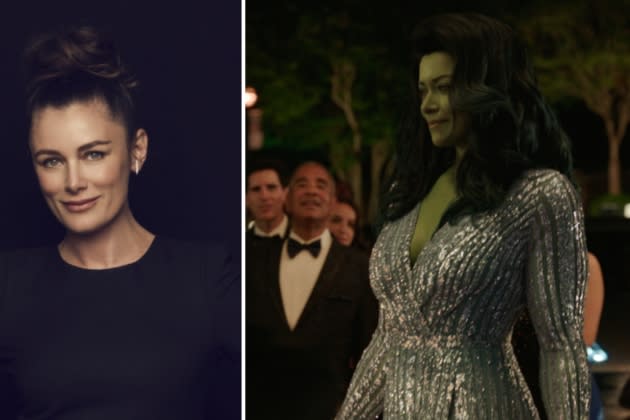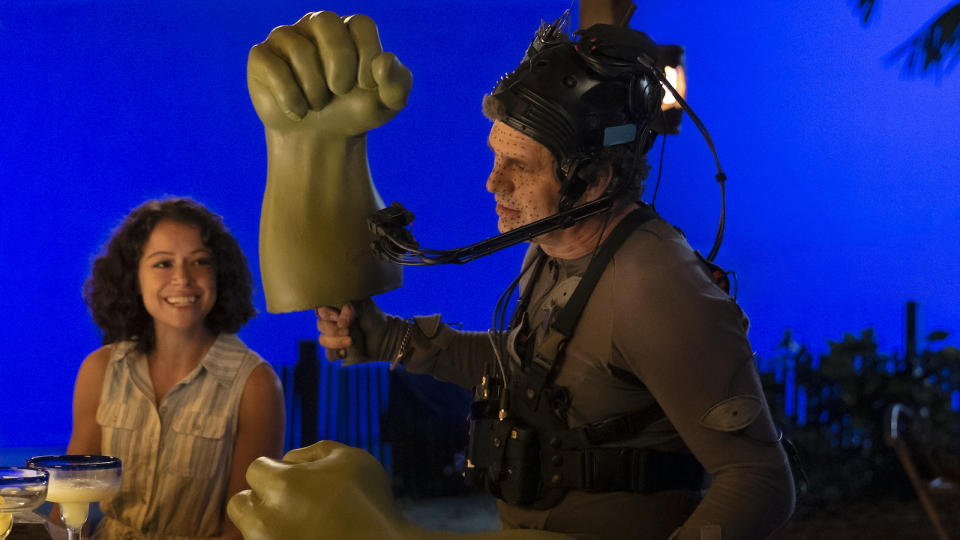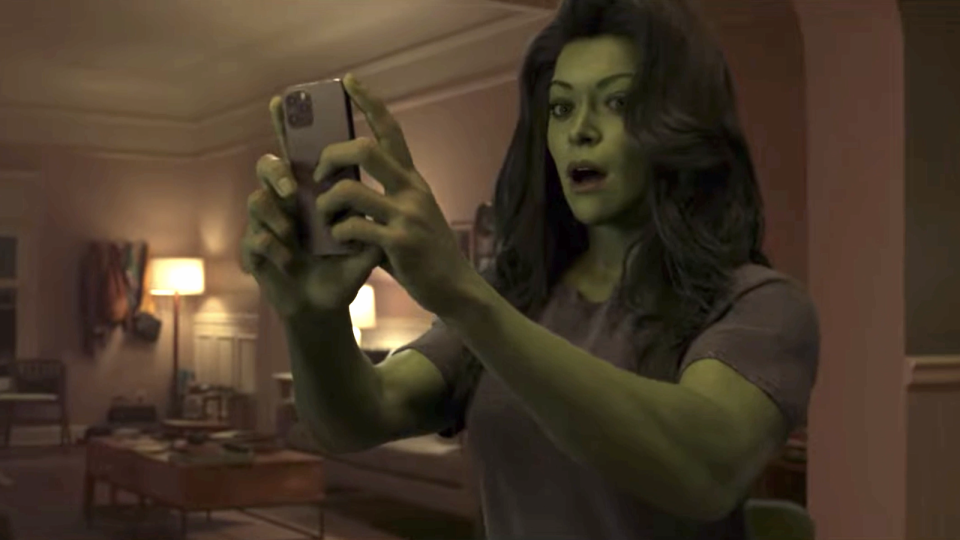‘She-Hulk’ Director Kat Coiro on the ‘Ally McBeal’ ‘Vibe’ of Marvel’s First TV Comedy and Developing Jennifer Walters’ Giant, Green Look

The first day Kat Coiro met with Marvel Studios to discuss potentially directing episodes of “She-Hulk: Attorney at Law” was the same day the world shut down during the COVID-19 pandemic.
“So, you know, there was a little pause,” she tells Variety. “But it was during that time that I actually developed a lot of my pitch.”
More from Variety
That time to fully develop her vision for the show proved crucial for the veteran director, who has helmed episodes of “Brooklyn Nine-Nine,” “It’s Always Sunny in Philadelphia,” “Modern Family,” “Dead to Me” and “Girls5Eva,” as well as the recent Jennifer Lopez romantic comedy “Marry Me.” Because while the Marvel Cinematic Universe has always included comedic moments since its inception with 2008’s “Iron Man,” “She-Hulk” marks the first outright TV comedy ever attempted in the MCU.
“There’s a reason that so many comedies are very lo-fi,” says Coiro, who also serves as an executive producer on the series. “They’re just about the joke, and they’re not about the visuals.”
By its very premise, however, “She-Hulk” was always going to be an extremely visually driven show. It follows mild-mannered lawyer Jennifer Walters (Tatiana Maslany), who becomes a Hulk after she’s exposed to blood from her cousin, Bruce Banner (Mark Ruffalo), in a car accident. Unlike Bruce — who spent years integrating his consciousness with his Hulk persona prior to the events of 2019’s “Avengers: Endgame” — Jennifer is able to fully inhabit her She-Hulk persona from the start. So for Coiro, the issue was how to honor the subtle, everyday comedic beats of the show but also “have it fit into this world that is very, very visual and grand.”
“I come from a background of straight comedy,” she says. “And so it was using all the tools I’ve picked up along the way in the comedy world, but then elevating it visually.”
Coiro talked with Variety about the technical preparation and innovation that went into bringing “She-Hulk” to (digital) life, as well as addressing developing She-Hulk’s appearance, the show breaking the fourth wall and why she would love to work again with Marvel Studios — but won’t be for a while.
What were some of the key things that you felt you needed to do to ensure that the comedy of “She-Hulk” wasn’t swallowed up by the cinematic, superhero part of the storytelling?
It’s really about pinpointing those comedic scenes that are about rhythm and banter and dialogue, and allowing those to be shot in the way that traditional comedies are — often cross shooting and allowing actors to improvise. Now, you add to that CG characters, and it’s a whole ‘nother level of complex. When you watch the first episode, you see that Mark [Ruffalo] and Tatiana [Maslany] are bantering. There’s a comedic point of view there. They’re also two CGI characters who require incredible amounts of VFX passes. So it was about being really prepared, knowing exactly how we were going into it, so that we could then allow them space to have fun. That really is the challenge. You have to have fun. To have a comedy, there has to be a sense of playfulness. There has to be a sense of trust that you can improvise and go off script and explore things.
And there were so many things that came from watching those two together. The whole montage of the Hulks training [took up] an eighth of the page, and it was a lot more about her resisting the desire to be a Hulk. But then when we saw Mark and Tatiana together and their energy and how playful and sibling-like it was, we said, “We have to add this montage of them having fun and seeing her live in her Hulk body.” Even though she’s resisting being it, it’s still pretty fun to be that strong.
Playing a CG character like this often involves wearing a motion capture suit, with cameras pointing at the actor’s face, and their character’s head above them on a stick to give the proper eye-line. But I imagine that makes it harder for that sense of playfulness, so how did you approach compensating for it?
Well, it was really about preparing the technical aspects to within an inch of our lives. We made sure that we were not figuring out the technical aspects in the moment. We tested out all of these techniques for the CGI characters so that when we came [to set], I could say, “Here’s what we’re doing, now you guys just do the scene as if you’re doing the scene in a regular situation.” That doesn’t mean they didn’t still have things they have to juggle. But I did the best that I could to take care of all that in prep. And we were discovering new ways, because there really hasn’t been a character that lives in the real world and is CGI like this. So there was a lot of experimentation and exploration.
What was something you discovered that ended up working?
Building the platforms [for the actors to walk on as a Hulk] ended up being really helpful. Having rehearsals days before or sometimes the night before so that we could have the grips build the platforms based on the blocking that came from the actors. One of the methods that we used early on was the [head on a] stick, but then all the scene partners have to look at this cardboard head instead of the actors eyes, which is very challenging to do. It also disconnects the actors from each other. So once we started getting into a rhythm of rehearsing and building the platforms in advance, you could let them come in and play out the scene almost like they normally would. A lot of the stuff between Jen and Smart Hulk, and She-Hulk and Smart Hulk, was all on pre-built platforms that we built after watching the actors rehearse and taking in their blocking.

“Ally McBeal” plays on the bar TV in an early episode. Was that show a touchstone for you at all in life or for this show?
No. I was not necessarily an “Ally McBeal” fan, but I knew all about it when it was on, because it did break so many conventions. It played with the law firm genre and turned it on its head and made it very feminine. When I heard they were doing “She-Hulk” — before I had a meeting, before I’d seen a scene from a script — I thought, “Oh, I hope that it’s got an ‘Ally McBeal’ vibe,” meaning breaking the fourth wall and really bringing that femininity into the courtroom. When I read it, I definitely felt like there was an “Ally McBeal” vibe. There are different accounts of how much “Ally McBeal” has influenced the show. But for me, it was something that I went back and watched after I started talking about “She-Hulk” with Marvel.
Were there any other TV shows, legally based or otherwise, that were also inspirations for you?
“Legally Blonde” is another one that just turns the expectations of a law story on its head, and it’s something we also have some little easter eggs in the show about. But honestly, I really leaned into watching the Marvel Cinematic Universe, and finding how do we take this new genre and have it still fit. Because you’re not just making one project. You’re making a project that is linked to all the other projects.
Had you previously seen a lot of the MCU movies and shows?
I had seen them all. Right before I met with Kevin [Feige, president of Marvel Studios] and the gang, I watched every single project in sequential order, and it was pretty fascinating. As a filmmaker, as an audience member, you just realized that the scope of this is something that has never been done, and the way that it has evolved — kind of as an organism, it’s changed over the years based on what the audience wants. There’s an interactive quality to it. I’d seen Marvel movies, but watching them all at once made me feel like I had to honor being a part of that universe.
How much visual inspiration did you want to draw from the “She-Hulk” comics? There are a lot of different interpretations of how Jennifer looks when she’s She-Hulk.
We definitely found our own way. I love the comics, and the comics are very different. She changes based on the artists. We definitely looked at all of that and took it into consideration. But like those artists before us, we made our own She-Hulk. You know, there’s been a lot of talk about, oh, she should have been bulkier. But we were very much inspired by Olympic athletes, by Misty Copeland, by women of enormous strength who aren’t necessarily bodybuilders. She’s not somebody who goes to the gym. She’s not a trained fighter. She’s someone who gets these powers and is inherently very, very strong.
Well, Bruce Banner, at least in the MCU, is also someone who isn’t really an athlete or a fighter, but when he transforms into the Hulk, he’s just ginormous. What did you want to communicate visually about Jennifer’s transformation and the difference between Jennifer and She-Hulk?
She-Hulk retains her sense of self fully, and that’s the huge distinguishing mark between She-Hulk and He-Hulk. When he first transforms, he becomes a rage monster. She is Jennifer Walters in a larger form. It was very important to us that she was able to still live her life. Yes, she’s giant and green, and it’s different from how she is as Jennifer Walters. But it’s not so radically different that she can’t go on dates; she can’t work in an office and sit in a regular desk; she can’t go shopping with her friends. I mean, we had a double on set who was a six-foot-seven woman. So we wanted her very much to be in the realm of the real. Whereas, you know, when you go back to the original Hulk, he is a monster. He doesn’t fit into the human world, and that’s part of his story. She-Hulk and Hulk are on very different journeys, and we wanted to make sure that they felt very separate, and not like, “Oh, she’s just the girl version doing the same thing.”

There’s an episode where Jennifer experiences how much more desirable she is as She-Hulk than as her human self. How did you want to approach that aspect of her character?
Tatianna and I talked a lot about the fact that she retains her consciousness, and, yet, she is changed by the way people see her. The way she is perceived actually ends up altering the way that she behaves. I think you can see that when she goes on the dates. Is it that she’s inherently more attractive in this form? Or is she a more confident version of herself because of the way that people see her? And you do see a physical difference, even in the first episode, where she first transforms. We really played with this idea of suddenly feeling huge and you take up space, and you can see in that little moment that she’s feeling so different. Feeling large is something that I think — a lot of women don’t want to feel large. They make themselves small. They’re used to being told, “Don’t take up too much space, don’t take up too much attention.” She can’t help it. How does that change her?
Jennifer also talks to the audience and acknowledges that she is on a TV show. Marvel has often had a kind of winking quality, but this is the first time the MCU has ever gotten this meta. How did you find the balance so you weren’t necessarily winking too much?
It was definitely an exploration. We knew we wanted to shoot more than we would use. There was more scripted, and we knew we would pepper it in and use it when it was appropriate. You want to use it as the wink to the audience, drawing them in. But if you do too much, then they lose sight of the story and the characters. If she’s turning to the camera every three minutes, you’re not going to be invested in her friends and her dates and her family and her cousin. But I think we ended up finding it along the way.
You directed the majority of the show — would you want to return to the MCU again?
I would work with Marvel again in a heartbeat. I’m working right now on a Disney+ series called “The Spiderwick Chronicles” that I’m executive producing. And then I actually have two films in the pipeline. I have a film for Sony called “The Husband’s Secret,” based on the Liane Moriarty novel, and then I’m doing an action adventure with Glen Powell and Nick Jonas. So I am going to be busy for a little while. But I would always work with Marvel again. It’s a really, really gratifying creative experience and very different than any other.
Different in what way? What was the most surprising thing for you?
I think the most surprising thing for me was that it’s not an incredibly rigid world. It really is a may-the-best-idea-win, let’s-all-make-this-together [experience]. People always ask me, “Is Kevin [Feige] involved?” Kevin is very involved. You’re constantly trying things out, especially in the prep phase — trying out scenes and getting them all the way to pre vis and then going, “You know what would be better? This would be better.” I think it’s a very unusual way to work. And it ends up being really gratifying, because you get to try things out, and you get to play around with your co-collaborators.
This interview has been edited and condensed.
Best of Variety
From 'The Sandman' to 'Blonde': Books Made Into Movies and TV Series That You Should Read
Jennette McCurdy's Provocative Book 'I'm Glad My Mom Died' Is Already a No. 1 Bestseller
Sign up for Variety’s Newsletter. For the latest news, follow us on Facebook, Twitter, and Instagram.

